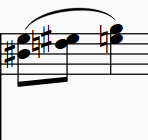
bigmaner123
Members-
Posts
23 -
Joined
-
Last visited
-
Days Won
1
bigmaner123 last won the day on July 7 2020
bigmaner123 had the most liked content!
About bigmaner123

- Birthday 09/13/1981
Profile Information
-
Gender
Male
-
Favorite Composers
Mahler, Chopin, Paganini, Brahms, Beethoven, Mozart, Shostakovich, Debussy, Sibelius.
-
My Compositional Styles
Anything but contemporary
-
Notation Software/Sequencers
Sibelius
-
Instruments Played
Piano
Recent Profile Visitors
918 profile views
bigmaner123's Achievements
-
I made a plan for the keys of the movements and how i wanna structure each movement and stuff, I already have a sense of what i wanna say with the music, however i can't really express it as smoothly as i want, that's why i was unsure if i should focus on a smaller size work before composing something like a symphony. Thanks for the sibelius tip!
-
Hi. thanks for listening and commenting, i will change the time signature to 6/8. Regarding the weird rhythms i tried placing the note on the 2nd beat, but it seemed to come to soon, when i did it with the original score it came on about where i wanted it to, i tried to make a ten-tunplet in Sibelius however i don't really know how to, i'll also respell the accidentals. If you could go more in-depth on how to fix the rhythmic thing i would be grateful. I started working on a 2nd movement however, i'm getting slightly discouraged at writing an entire symphony, i scrapped the 2nd movement and decided to make the 1st movement into a extended symphonic work like something ravel would do, however i don't know if thats a good idea, i've never been really good at writing extremely long pieces of music. Would you have any recommendation's on what i should do?
-
bigmaner123 started following Afterglow , Symphonie No .1 ''The Magicians Symphony'' 1st mvt , Can woodwinds play multiphonics fast? and 2 others
-
Hello everyone, this is the first movement of a symphony that i'm making, the is my first draft of the first movement, i would like to know people's opinion and critique of this work. I had to redo this movement many times, and it was tough putting it all together, nevertheless i hope you all enjoy it to some extent.
-
Can woodwinds play multiphonics fast?
bigmaner123 replied to bigmaner123's topic in Advice and Techniques
Okay, thanks very much for the knowledge! -
Can woodwinds play multiphonics fast?
bigmaner123 replied to bigmaner123's topic in Advice and Techniques
Hmm, i see, so is it just better to voice one note, and spread the other note to say the piccolo, or another instrument? -
Can woodwinds play multiphonics fast?
bigmaner123 replied to bigmaner123's topic in Advice and Techniques
-
If you have 2 notes a third apart, C and E, could a flute play them fast legato?
-
The bass doesn't need to play the whole chord, the bass usually plays the root of the chord, so for example so if you have a c Major chord, the bass would usually play a C, if the chord was in root position. Now, if the chord is in an inversion there is a special rule, the bass doesn't play the root of the the 1st inversion, because it would ''weaken'' the chord, that is, because in every scale you have strong degrees of tonality and weak degrees of tonality, for example in C major, the strong degrees are The tonic, the subdominant and the dominant, So C major, F major and G major, so if you used a first inversion chord of c major the bass would usually play either C or G, as to not weaken the chord(the strong degrees are always I, IV, V) (the weak degrees are III,VI). So what happens is that the bass usually plays one note of the chord and the other instruments play the other notes, and sometimes a note is doubled, the doubled note is most commonly the root or the dominant, because like i've said before you don't want to double the third. There is a small arbitrary rule to this which is the 2nd chord of the scale, which can act as a strong or weak degree paradoxically, and the 7th degree is not considered a chord, since it is just a V7 chord without the root. So essentially share the chord between the instruments and make one instrument play a melody over those chords, try this out until you get used to it. And then try more advanced techniques using suspensions, Appoggiaturas and Larger chords, like 7th, 9, 11th, 13. And more complicated chords like diminished chords and Neapolitan. This is a lot of information but if you dissect this paragraph and learn about each things your composition will improve dramatically. One book i recommend that has all of these things is a book called harmony by walter piston, if you wish to learn harmony that is. He also has a book on counterpoint which is useful as well, but i would say his book on harmony is much better.
-
Hi, this piece is good in one aspect which is in its melody, i don't mean to say this to put you down, but i want to help you see what you could do better. 1. First off, the choice of instruments in this piece are quite unusual, for example only choosing the violin and cello is quite weird, it would be better to add one more violin and a viola, and if you wanted to a double bass, this might make the harmony flourish more and make it sound better. 2. There is a lot of doubling in this piece, that is to say, the piano and flute almost always play the same notes at the same time, this is really bad to constantly have, since it basically means that the piano isn't a instrument, solely just a single voice, you want to individualize each instrument to some extent, this can be done mainly through counterpoint or harmonic texture. 3. The percussion is unusual but i see what effect you're going for. 4. as such the main thing you want to focus on is number 2, i also suggest you read up about harmony and counterpoint, as they will serve you very well in the future, but without expanding each instrument to their capacity, then you merely just have a voice instead of an instrument. 5. Just a side note, doubling is fine in larger works like an orchestra but it usually becomes less powerful when the size of the orchestra or piece is smaller, for example a duet would rarely have a doubling of voices.
-
Okay, thank you i dont want them to glis, i just want them to hit a single note.
-
So this is a short but important question, when writing for timpani's is it possible for the timpanist to play chromatic notes in a fairly rapid succession or does he need time to adjust the pressure of the timpani? for example could he play 3 crochest of E, D Sharp, and C sharp at a fairly moderate speed?
-
Really like this piece, its really groovy. Sounds like something you would hear in a persona game. Keep it up!






